Mulesoft MCD-Level 1 MuleSoft Certified Developer – Level 1 (Mule 4) Online Training
Mulesoft MCD-Level 1 Online Training
The questions for MCD-Level 1 were last updated at Dec 24,2025.
- Exam Code: MCD-Level 1
- Exam Name: MuleSoft Certified Developer - Level 1 (Mule 4)
- Certification Provider: Mulesoft
- Latest update: Dec 24,2025
A web client submits a request to http://localhost:8081?accountType=personal. The query parameter is captured using a Set Variable transformer to a variable named account Type.
What is the correct DataWeave expression to log account Type?
- A . Account Type: #[flowVars.accountType]
- B . Account Type: #[message.inboundProperties.accountType]
- C . Account Type: # [attributes.accountType]
- D . Account Type: #[vars.accountType]
D
Explanation:
vars: Keyword for accessing a variable, for example, through a DataWeave expression in a Mule component, such as the Logger, or from an Input or Output parameter of an operation. If the name of your variable is myVar, you can access it like this: vars.myVar Hence correct answer is Account Type: #[vars.accountType]
Refer to the exhibit.
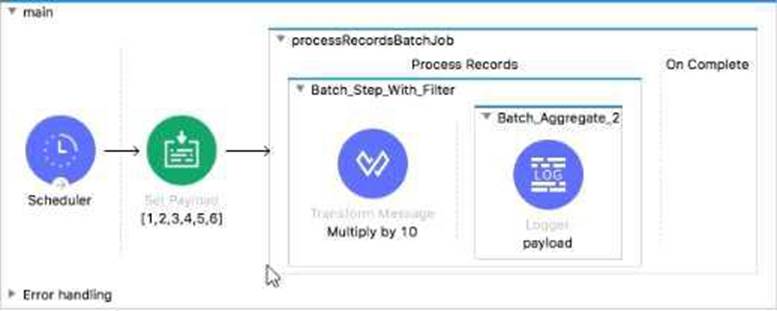
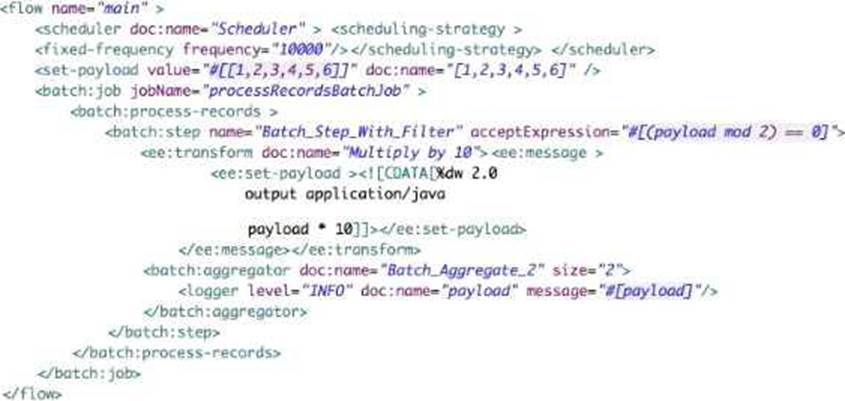
The Batch Job processes, filters and aggregates records,.
What is the expected output from the Logger component?
- A . [10. 20, 30. 40, 50, 60]
- B . [10. 20] [30, 40] [50, 60]
- C . [20, 40, 60]
- D . [20. 40] [60]
D
Explanation:
* Batch scope has filter criteria which says paylod mod 2 = 0 whch means only 2, 4 and 6 will be in batch scope.
* So payload for each of these will be incremented by 10.
* Aggregator has batch size defined as 2. So it will process in batch of two records.
* Hence option 3 is correct answer.
[20,40]
[60]
Behavior with aggregator configured with fixed size
In this scenario, the batch step sends the processed records to an aggregator, which starts processing the records and buffering them until the configured aggregator’s size is reached. After that, the aggregator sends the aggregated records to the stepping queue.

The batch job builds record blocks of the configured block size and sends them to their corresponding batch step for processing. Each batch step receives one or more record blocks and starts processing them in parallel. After the batch step processes a record, the batch step sends the record to the aggregator for further processing. The aggregator continues processing records until the number of
aggregated records reaches the configured aggregator’s size. https://docs.mulesoft.com/mule-runtime/4.3/batch-processing-concept
Refer to the exhibits.
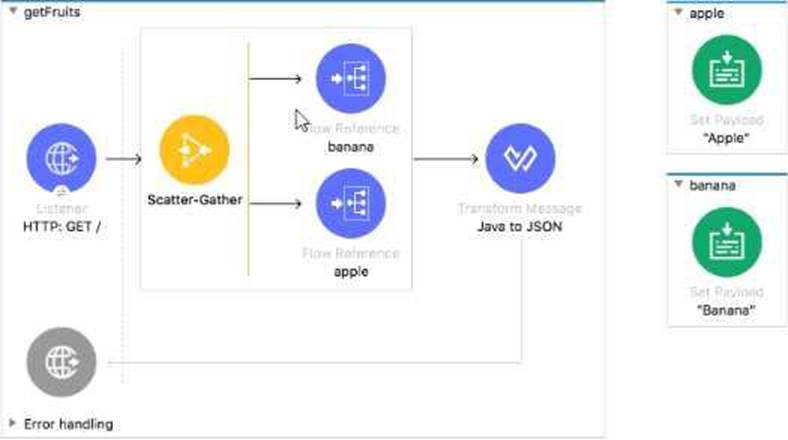

A web client submits a request to http://localhQst:8081.
What is the structure of the payload at the end of the flow?
A)
![]()
B)

C)

D )
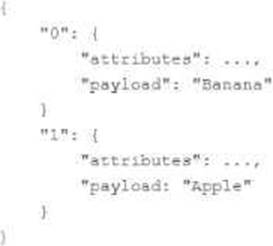
- A . Option A
- B . Option B
- C . Option C
- D . Option D
D
Explanation:
Scatter-Gather Router
The Scatter-Gather component is a routing event processor that processes a Mule event through different parallel processing routes that contain different event processors. Each route receives a reference to the Mule event and executes a sequence of one or more event processors. Each of these routes uses a separate thread to execute the event processors, and the resulting Mule event can be either the same Mule event without modifications or a new Mule event with its own payload, attributes, and variables. The Scatter-Gather component then combines the Mule events returned by each processing route into a new Mule event that is passed to the next event processor only after every route completes successfully.
The Scatter-Gather component executes each route in parallel, not sequentially. Parallel execution of routes can greatly increase the efficiency of your Mule application and may provide more information than sequential processing.
Mule Ref Doc: https://docs.mulesoft.com/mule-runtime/4.3/scatter-gather-concept
Refer to the exhibits.
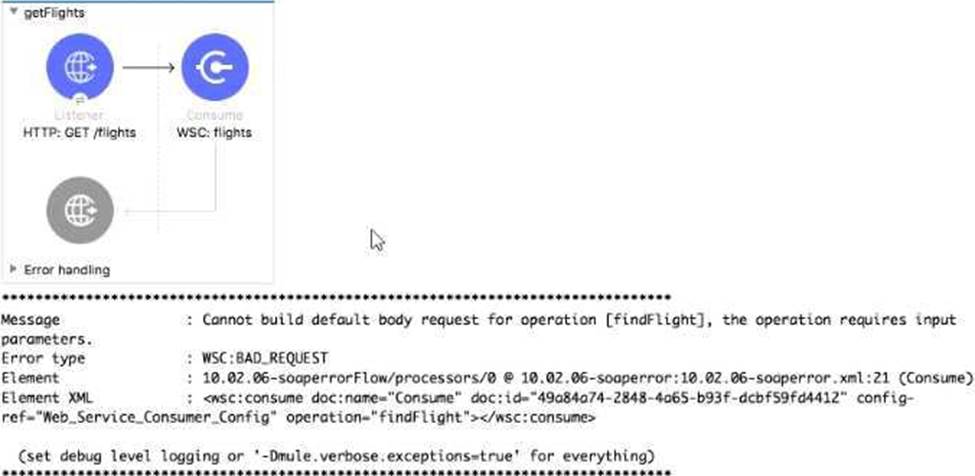
A web client submits a request to http://localhost:8081/fliqhts?destination=SFO and the Web Service Consumer throws a WSC: BAD_REQUEST error.
What is the next step to fix this error?
- A . Set a header In the Consume operation equal to the destination query parameter
- B . set a SOAP payload before the Consume operation that contains the destination query parameter
- C . set a property m the Consume operation equal to the destination query parameter
- D . set a JSON payload before the Consume operation that contains the destination query parameter
B
Explanation:
As can be seen in error message, SOAP service findFlights expects the SOAP paylaod. This can be set using transform message processor which forms SOAP payload before the Consume operation that contains the destination query parameter
What valid RAML retrieves details on a specific by its orderld as a URL parameter?
A)
![]()
B)
![]()
C)
![]()
D)
![]()
- A . Option A
- B . Option B
- C . Option C
- D . Option D
An HTTP Request operation sends an HTTP request with a non-empty JSON object payload to an external HTTP endpoint. The response from the external HTTP endpoint returns an XML body. The result is stored in a target named the Result.
What is the payload at the event processor after the HTTP Request?
- A . The XML response body
- B . null
- C . The original JSON request body
- D . A non-empty Java object
According to MuleSoft. what is the first step to create a Modern API?
- A . Gather a list of requirements to secure the API
- B . Create an API specification and get feedback from stakeholders
- C . Performance tune and optimize the backend systems and network
- D . Create a prototype of the API implementation
B
Explanation:
First step in creating Modern API is to create an API specification and get feedback from stakeholders so that any future issues can be identified at early stage thereby reducing overall delivery time
Reference: https://developer.mulesoft.com/tutorials-and-howtos/quick-start/designing-your-first-api
Refer to the exhibit.
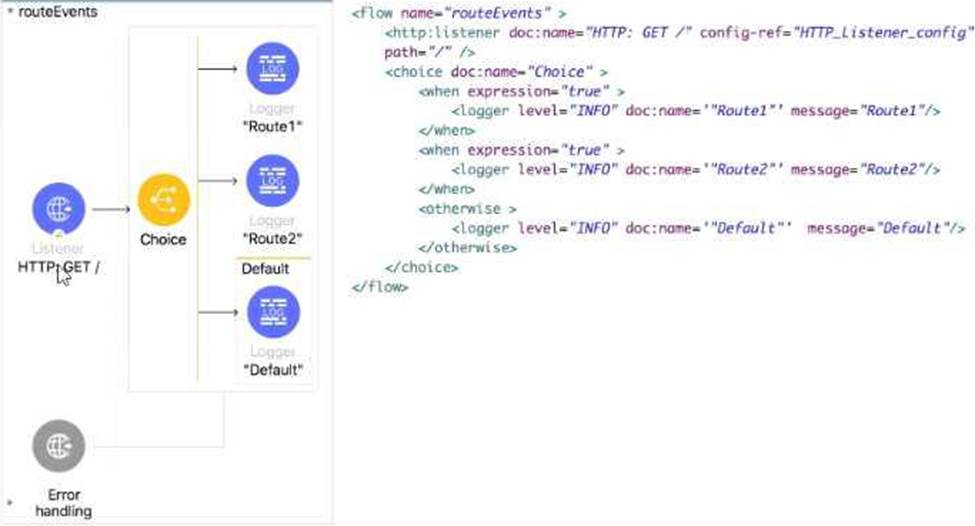
All three of the condition for the Choice router are true.
What log messages are written?
- A . Route 1
- B . Route2
- C . Route1, Route2
- D . Route1, Route2, Default
Refer to the exhibit.
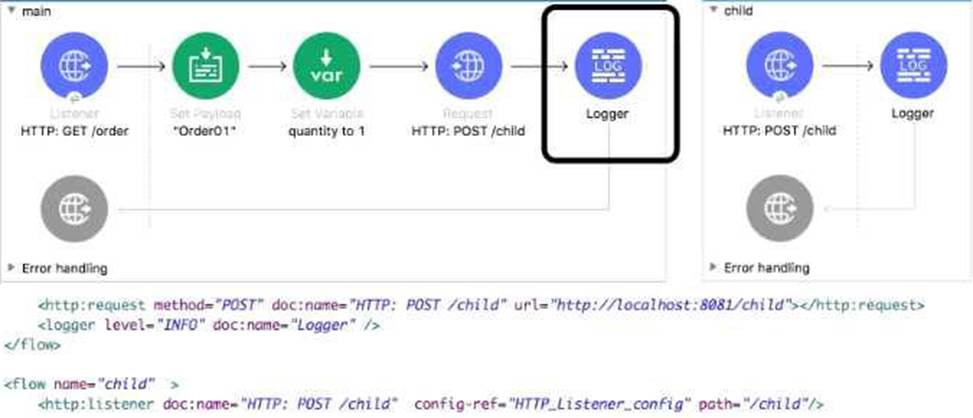
The main flow contains an HTTP Request in the middle of the flow. The HTTP Listeners and HTTP request use default configurations.
What values are accessible to the Logger at the end of the flow after a web client submit request to http://local:801/order?color=red?
- A . payload
- B . payload quantity var
- C . payload color query param
- D . payload quantity var color query param
B
Explanation:
In this case as outbound call is made using HTTP: POST /child, all attributes will be replaced by this invocation. Hence query parameter will not be accessible at logger.
Refer to the exhibit.
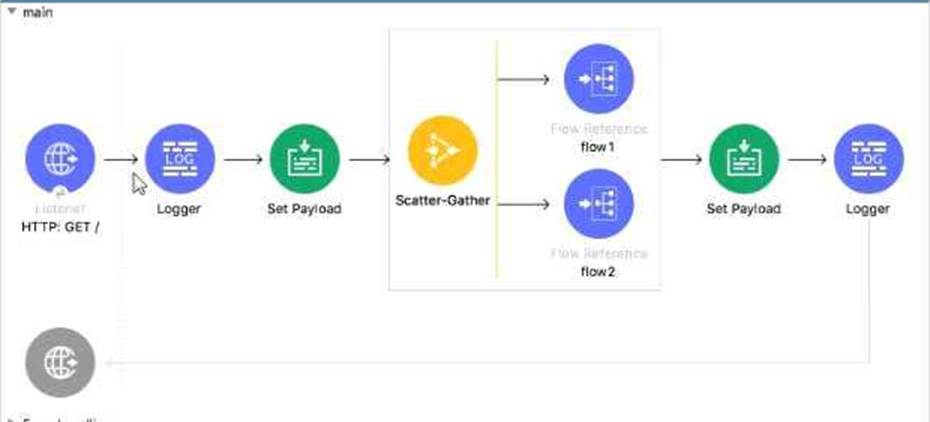
In the execution of the Scatter_Gather, the flow1 route completes after 10 seconds and the flow2 route completes after 20 seconds.
How many seconds does it take for the Scatter_Gather to complete?
- A . 0
- B . 10
- C . 20
- D . 30
Latest MCD-Level 1 Dumps Valid Version with 99 Q&As
Latest And Valid Q&A | Instant Download | Once Fail, Full Refund

